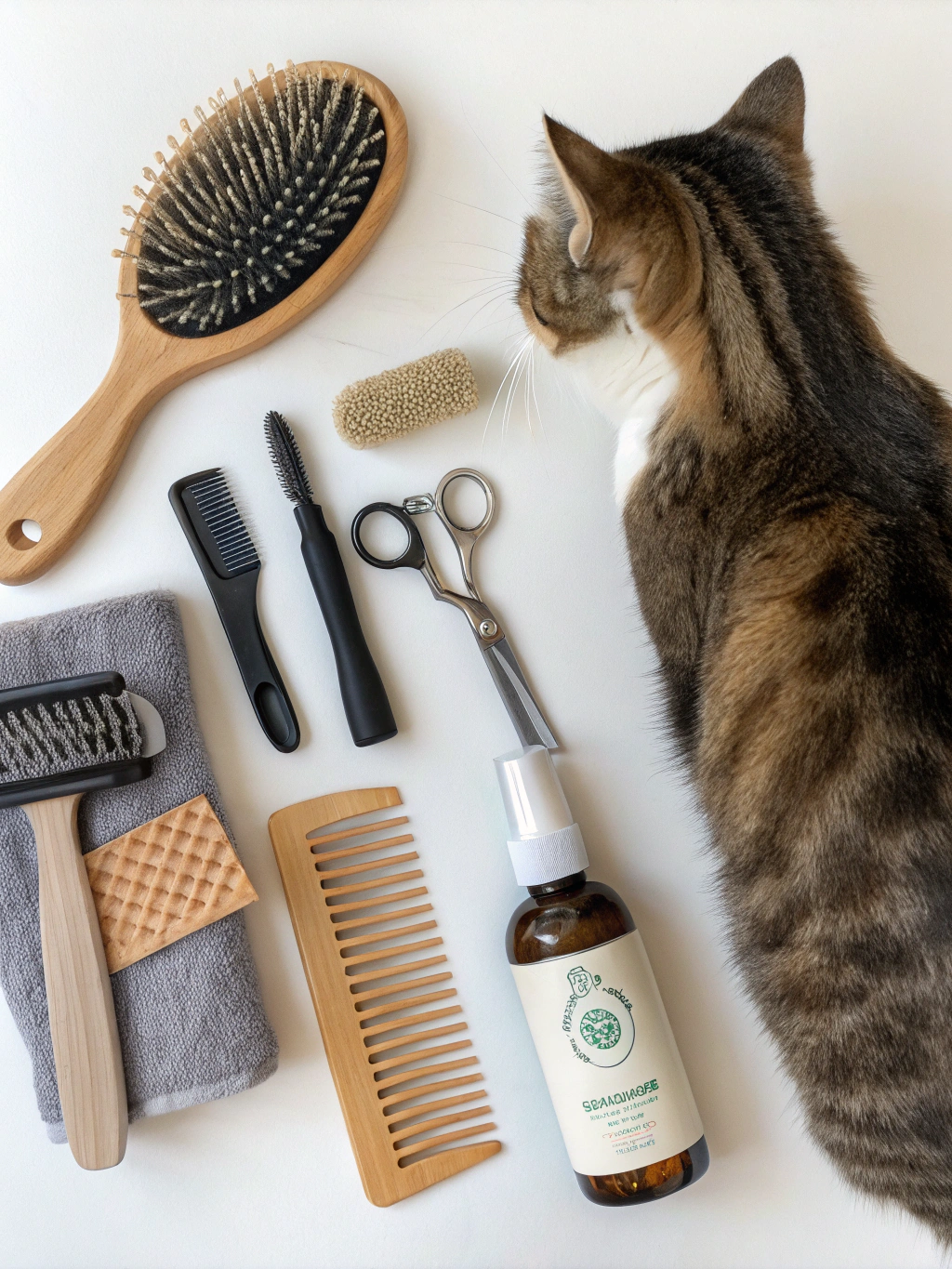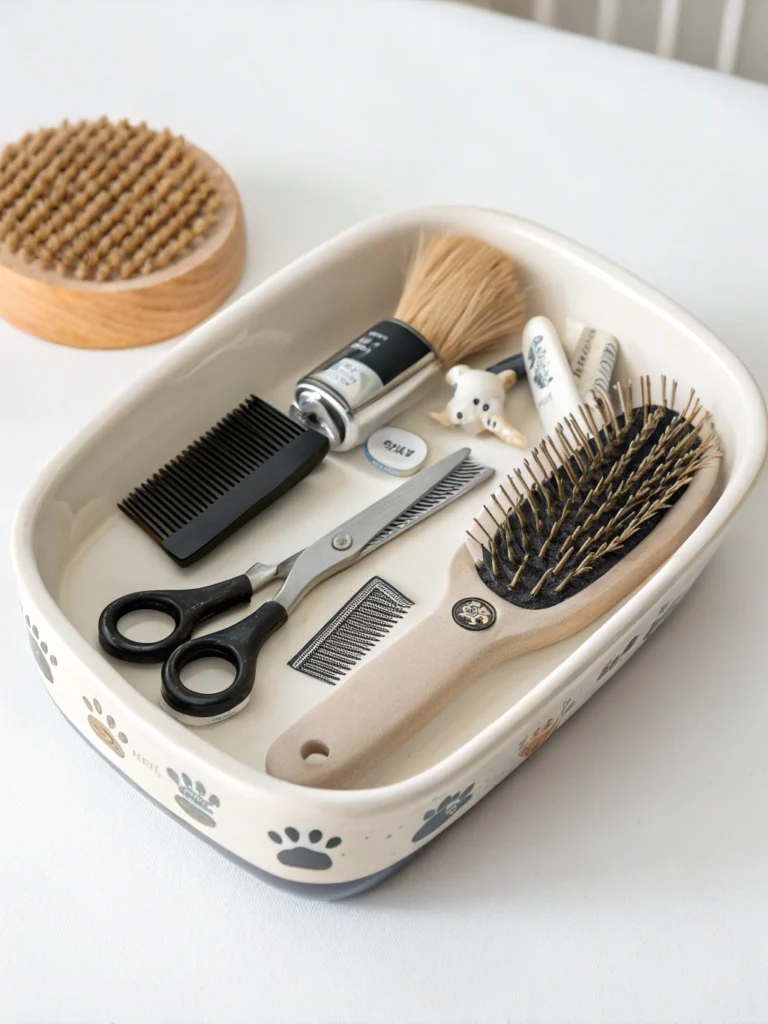Table of Contents
Did you know that cats spend approximately 50% of their awake time grooming themselves? While this instinct keeps them relatively clean, it doesn’t mean they don’t need some extra help from their human companions. Proper grooming is essential for maintaining a healthy coat, preventing matting, reducing hairballs, and even spotting potential health issues early on. So, how can you ensure your feline friend stays impeccably clean and content? Plenty of resources are available to help you, including comprehensive guides on cat grooming tips that cover everything from brushing to nail trimming. Let’s dive into the world of feline grooming together!
Ingredients List
Alright, let’s start gathering what you’ll need for a successful grooming session! Here’s our toolkit:
- Soft-bristled brush or grooming mitt: Ideal for removing loose hair and massaging your cat’s skin simultaneously.
- Fine-toothed comb: Perfect for tackling any stubborn tangles or mats, especially useful for long-haired breeds.
- Cat-friendly shampoo: Choose a mild formula specifically designed for felines to avoid skin irritation.
- Washcloth or sponge: Essential for gentle cleaning, especially around the face and ears.
- ** Cotton balls**: Useful for cleaning delicate areas like ears without causing irritation.
- Nail clippers designed for cats: Ensure a clean, safe trim to prevent overgrowth or splitting.
- Treats: Always a great motivator to keep your feline friend cooperative and rewarded during the process.
- Hairdryer on a low, cool setting (optional): Ideal for drying your cat’s coat, especially in cooler weather, without causing stress.
Substitutions: If you don’t have a specialized cat brush, a soft toothbrush (never used on humans, of course!) can work in a pinch. For trimming nails, human nail clippers can be used cautiously, but cat-specific clippers are highly recommended for safety and precision.

Timing
Grooming your cat doesn’t have to be a time-consuming chore! Depending on your cat’s coat type and how frequently they are groomed, a session typically takes:
- Short-haired cats: 10-15 minutes per session (2-3 times a week)
- Long-haired cats: 20-30 minutes per session (daily or bi-weekly)
Over time, regular grooming sessions may really get faster and more effective as you and your cat grow accustomed to the procedure. A DIY grooming plan saves both time and money when compared to bringing your cat to a professional groomer, which can take anywhere from 1-4 hours depending on the services required. Indeed, a little at-home TLC may completely change your cat’s daily existence into one rich with comfort and care.
Step-by-Step Instructions
1. Brushing Your Cat’s Coat
Brushing is vital to keeping a healthy coat, so begin with that. Start with a soft-bristled brush to remove any stray hair and encourage the skin. Give particular care to spots susceptible to matting, such behind the ears and beneath the armpits. For long-haired breeds, use a fine-toothed comb to softly work out any knots. To prevent pain, always brush in the direction of the fur development.
Pro Tip: Use this time to bond with your cat. Talk to them in a soothing voice and offer plenty of praise and affection. This can help make grooming a positive experience for them. If you have a long-haired cat, consider reading how to groom a long-haired cat for more detailed guidance.
2. Cleaning Your Cat’s Ears
Gently clean the inside of your cat’s ears with a soft cloth or wet cotton ball. Never put anything inside the ear canal; only clean the exposed areas of the ear as doing so might harm or infection. Should your cat’s ears seem very filthy or if you detect a bad smell, see your veterinarian as this could suggest a deeper problem.
3. Bathing (If Necessary)
Most cats will remain quite clean on their own, but occasionally a wash is required, particularly for long-haired types or if they get into anything very filthy. Put a few inches of lukewarm water in a sink or bathtub. Avoid the eyes, ears, and nose while using the cat-friendly shampoo to softly lather and wash your cat. You may towel dry your cat after thorough cleaning or, if they tolerate it well, use a hairdryer on a low, cold setting.
4. Nail Trimming
For both cat and owner, this is usually the most difficult stage! Starting to clip your cat’s nails while they are young can help them to become used to the procedure. Avoiding the pink “quick” region containing blood vessels and nerves, use cat-specific nail clippers to cut only the very tip of each nail. Your first time, if in doubt, get a demonstration from your veterinarian.
5. Dental Care – Brushing Their Teeth
Dental health is equally as crucial as coat health! Gently clean your cat’s teeth with a finger brush or tiny pet toothbrush and pet-safe toothpaste. Begin with brief sessions and then raise them as your cat becomes more at ease with the practice. It can assist to avoid gum issues, poor breath, and dental illnesses.
6. Finishing Up – Praise and Reward
Always finish the grooming session on a high note. As a reward for their cooperation, provide lots of vocal praise, caressing, and sometimes a little food. Trust will be strengthened by this and future grooming appointments will be more convenient.
Nutritional Information
Although this article emphasizes grooming, a healthy diet has a big influence on the state of your cat’s coat. High-quality cat food heavy in Omega-3 and Omega-6 fatty acids can help to encourage a shinier, healthier coat. Your veterinarian should always be consulted on the ideal diet for your particular cat.
Regular grooming guarantees a bright coat, good skin, and a generally happier cat. Grooming is about being healthy as well as looking nice, so keep that in mind.
Healthier Alternatives for the Grooming Process
While grooming itself doesn’t involve food, enhancing your cat’s diet can greatly contribute to a healthier coat! Here are some tips:
- Omega-3 Supplements: Fish oil supplements are great for reducing inflammation and improving skin and coat health.
- Hydration: Ensure your cat drinks enough water, as hydration is key to preventing dry, flaky skin.
- Veterinary-Approved Foods: Feed your cat high-quality food approved by your vet, especially those formulated to support skin and coat health.
Serving Suggestions (Post Engagement Tips)
Once you and your cat are comfortable with the grooming routine, consider sharing your experience! Here are some serving suggestions for your newfound expertise:
- Instagram: Post before-and-after photos of your cat’s grooming routine. Tag relevant accounts and use hashtags like #DailyCatGrooming, #PerfectCatCoatCare, and #HappyCatCompanion.
- Facebook/Reddit Groups: Share your tips with fellow cat enthusiasts in online communities. Don’t forget to offer encouragement and advice.
- Personal Blog: If you run a personal blog, write an article detailing your cat grooming journey and share it with your followers.
Remember, sharing your experience can also help you learn new techniques and improve your cat grooming skills even more.
Common Mistakes to Avoid
- Skipping Regular Brushing: Irregular brushing can lead to mats and tangles, which can be painful for your cat and difficult to remove.
- Over-Dampening the Ears: Moisture can lead to infections, so ensure ears are completely dry.
- Trimming Too Much Nail: Cutting into the quick causes pain and bleeding. Always trim conservatively.
- Using Human Products: Human shampoos or toothpaste can be harmful to cats. Always use pet-specific products.
Avoiding these mistakes will ensure a safe, comfortable grooming experience for both you and your cat. If you’re ever unsure, consult with your vet or a professional groomer.
Storing Tips for the Grooming Process
Unlike food recipes, grooming doesn’t have “storage,” but maintaining equipment is essential:
- Keep Grooming Tools Clean: After each use, wipe down brushes, combs, and nail clippers. This prevents the buildup of oils, fur, and bacteria.
- Store Tools Properly: Keep grooming tools in a clean, dry location. You might consider using a small toolbox or drawer to keep them organized and accessible.
- Regular Inspection: Periodically check tools for signs of wear and tear, such as dull bristles or rust. Replace them as needed to ensure effective grooming sessions.
A well-maintained grooming kit will serve you and your cat for a long time, making each session smoother and more effective.
Conclusion
Grooming your cat at home is a gratifying activity that not only maintains their appearance but also greatly promotes their health and happiness. You can change what may appear to be a difficult chore into a pleasant bonding time with the correct tools, a mild attitude, and some patience. Ready to give it a go? Let’s assist one another keep our feline friends clean, healthy, and as happy as can be by sharing your experiences in the comments below.
FAQs
Is Professional Cat Grooming Necessary?
Professional grooming can be beneficial, especially for long-haired cats or those with complex grooming needs. However, regular at-home grooming can significantly reduce the need for professional services and strengthen the bond between you and your pet.
How Often Should I Groom My Cat?
The frequency depends on your cat’s coat type and lifestyle. Generally:
- Short-haired cats: Groom 1-2 times a week.
- Long-haired cats: Groom daily or bi-weekly.
- Outdoor cats or those prone to getting dirty: More frequent grooming may be necessary.
Always adjust according to your cat’s specific needs and tolerance.
Can Grooming Help Identify Health Issues Early?
Absolutely! Regular grooming allows you to inspect your cat’s skin, ears, nails, and overall coat condition. This can help you spot unusual lumps, parasites, infections, or areas of discomfort early, allowing for prompt veterinary care.
My Cat Hates Being Groomed—What Do I Do?
If your cat seems stressed or uncomfortable, start slow. Introduce grooming tools gradually, without actually grooming, and associate the experience with positive rewards (like treats or play). Allow your cat to set the pace and only attempt as much as they’re comfortable with at any given time. Over time, your cat may become more accepting of, and even enjoy, grooming sessions.
Ready to make grooming a positive, stress-free experience for your feline friend? Happy grooming!



